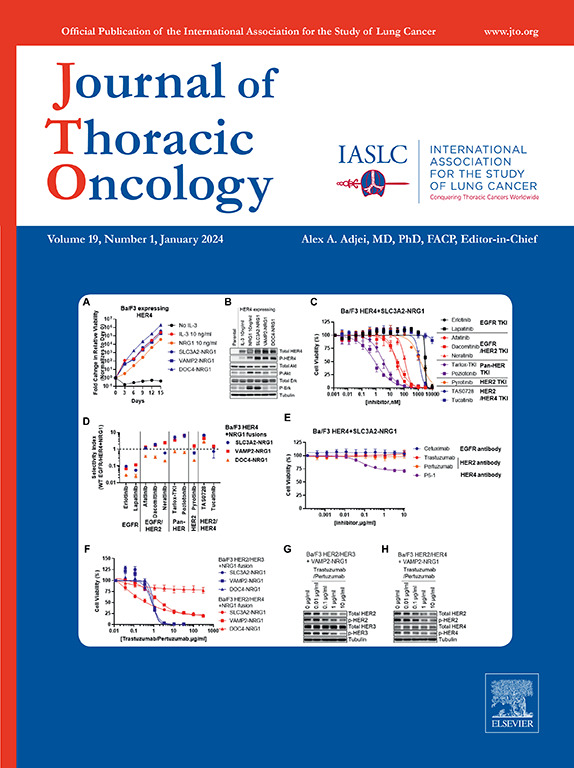针对 SLFN11 阳性广泛期小细胞肺癌患者的维持性阿特珠单抗 (A) 与阿特珠单抗 + Talazoparib (AT) 的 II 期随机研究。S1929.
IF 21
1区 医学
Q1 ONCOLOGY
引用次数: 0
摘要
目的:评估在前线化疗免疫疗法后,在维持性免疫检查点抑制剂(ICI)阿替佐珠单抗的基础上添加多聚(ADP-核糖)聚合酶抑制剂(PARPi)talazoparib是否能改善施拉芬11(SLFN11)阳性广泛期小细胞肺癌(ES-SCLC)患者的预后:新诊断的SLFN11表达(H评分≥1,中心评估)ES-SCLC患者在一线化疗加阿特珠单抗后,随机接受阿特珠单抗(A)与阿特珠单抗加他拉唑帕尼(AT)的维持治疗。首要目标是比较无进展生存期(PFS),采用单侧10%水平分层对数秩检验。次要终点包括客观反应率(ORR)、总生存期(OS)和毒性。目标样本量为84名符合条件的患者:2020年6月15日至2022年12月15日,106名符合条件的患者接受了随机治疗(54人接受AT治疗,52人接受A治疗)。AT与A相比,PFS有所改善(危险比[HR]为0.66;80%置信区间[CI]为0.50-0.86;1%置信区间[CI]为0.50):中位 PFS 分别为 2.9 个月和 2.4 个月;OS 组间无差异(HR,0.98;80% 置信区间 [CI]:0.71-1.36;单侧 P = 0.47)。17%的AT患者和14%的A患者发生了≥3级的非血液学治疗相关不良事件(TRAEs),≥3级的血液学TRAEs在AT(50%)中比在A(4%)中更常见(P<0.001):结论:SLFN11阳性ES-SCLC患者在接受初始化疗免疫治疗后,如果病情没有进展,维持AT可改善患者的PFS。正如预期的那样,AT会增加血液毒性,主要是3级贫血。前瞻性生物标志物选择得到了证实,为今后在分子定义的SCLC人群中评估新型疗法铺平了道路。本文章由计算机程序翻译,如有差异,请以英文原文为准。
Phase II Randomized Study of Maintenance Atezolizumab Versus Atezolizumab Plus Talazoparib in Patients With SLFN11 Positive Extensive-Stage SCLC: S1929
Objective
To evaluate whether the addition of a poly (adenosine diphosphate–ribose) polymerase inhibitor talazoparib to maintenance immune checkpoint inhibitor atezolizumab after frontline chemoimmunotherapy improved outcomes in patients with Schlafen 11 (SLFN11)-positive extensive-stage SCLC (ES-SCLC).
Methods
Patients with newly diagnosed SLFN11 expressing (H-score ≥ 1, evaluated centrally) ES-SCLC were randomized to maintenance atezolizumab (A) versus atezolizumab plus talazoparib (AT) after frontline chemotherapy plus atezolizumab. The primary objective was to compare progression-free survival (PFS) using a one-sided 10% level stratified log-rank test. Secondary endpoints included objective response rate, overall survival, and toxicity. The target sample size was 84 eligible patients.
Results
From June 15, 2020, to December 15, 2022, 106 eligible patients were randomized (54 to AT and 52 to A). Progression-free survival was improved with AT versus A (hazard ratio = 0.66, 80% confidence interval: 0.50–0.86, one-sided p = 0.019) with a median PFS of 2.9 and 2.4 months; overall survival was not different between groups (hazard ratio = 0.98, 80% confidence interval: 0.71–1.36, one-sided p = 0.47). Grade 3 and higher non-hematologic treatment-related adverse events occurred in 17% of patients with AT and 14% of patients with A. Grade 3 and higher hematological treatment-related adverse events were more common in AT (50%) than in A (4%) (p < 0.001).
Conclusion
Maintenance AT improved PFS in patients with SLFN11-positive ES-SCLC that did not progress after initial chemo-immunotherapy. Hematologic toxicity, primarily grade 3 anemia, was increased with AT, as expected. Prospective biomarker selection was demonstrated, paving the way for future evaluation of novel therapies in molecularly defined SCLC populations.
求助全文
通过发布文献求助,成功后即可免费获取论文全文。
去求助
来源期刊

Journal of Thoracic Oncology
医学-呼吸系统
CiteScore
36.00
自引率
3.90%
发文量
1406
审稿时长
13 days
期刊介绍:
Journal of Thoracic Oncology (JTO), the official journal of the International Association for the Study of Lung Cancer,is the primary educational and informational publication for topics relevant to the prevention, detection, diagnosis, and treatment of all thoracic malignancies.The readship includes epidemiologists, medical oncologists, radiation oncologists, thoracic surgeons, pulmonologists, radiologists, pathologists, nuclear medicine physicians, and research scientists with a special interest in thoracic oncology.
 求助内容:
求助内容: 应助结果提醒方式:
应助结果提醒方式:


